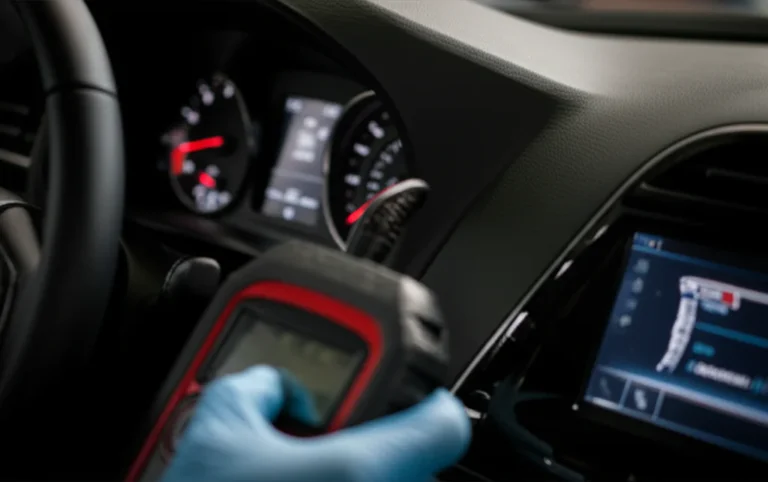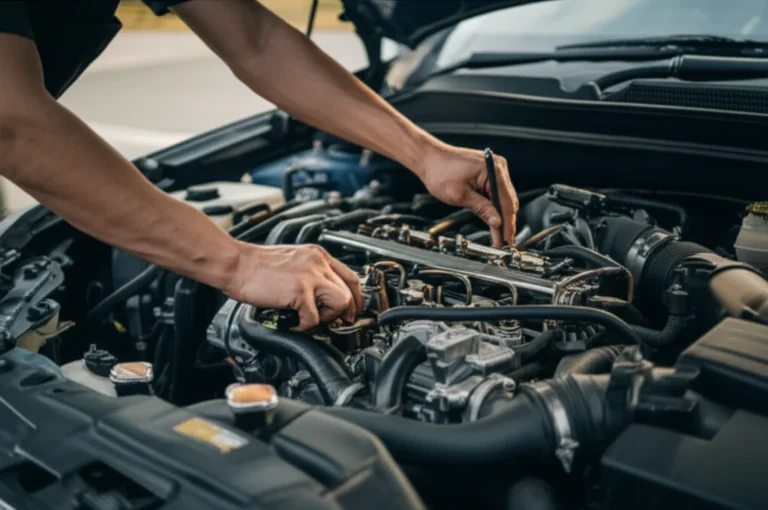Support our educational content for free when you purchase through links on our site. Learn more
Do Teslas Need Oil Changes? 7 Surprising Facts You Must Know (2025) ⚡️
If you’ve ever wondered whether your sleek, silent Tesla needs the same old oil changes as a gas guzzler, you’re not alone. At Car Brands™, we get asked this all the time. Spoiler alert: Teslas don’t require traditional engine oil changes at all! But that’s just the tip of the iceberg. From gearbox lubricants to brake fluid and tire care, maintaining a Tesla is a whole new ballgame.
Stick with us as we unravel the mysteries behind Tesla maintenance, bust common myths, and share insider tips that will save you time, money, and maybe even a few headaches. Did you know that regenerative braking can extend your brake pads’ life by years? Or that some Tesla fluids are designed to last the lifetime of the car? We’ll cover all this and more, so you can confidently care for your electric ride like a pro.
Key Takeaways
- Teslas do NOT need engine oil changes because electric motors don’t use engine oil.
- Maintenance focuses on tires, brake fluid, cabin air filters, and software updates.
- Regenerative braking significantly reduces brake wear, saving money and trips to the shop.
- Tesla’s gearbox uses a special lubricant that rarely needs changing.
- Routine maintenance costs for Teslas are generally much lower than traditional gasoline cars.
- DIY maintenance is possible for simple tasks, but some services require professional care.
- Skipping oil changes benefits the environment by reducing hazardous waste and resource use.
Ready to keep your Tesla in tip-top shape? Check out accessories like cabin air filters and jack pads to get started on your DIY maintenance journey!
Table of Contents
- ⚡️ Quick Tips and Facts About Tesla Oil Changes
- 🔋 The Evolution of Tesla and Electric Vehicle Maintenance
- 🔧 Understanding Tesla’s Electric Powertrain: What Makes It Different?
- 🛢️ Do Teslas Use Oil at All? Debunking the Myth
- 🛠️ 7 Essential Maintenance Tasks for Teslas (Hint: Oil Changes Aren’t One)
- 💸 Maintenance Costs: Tesla vs. Traditional Gasoline Vehicles
- 🔍 DIY vs. Professional Tesla Maintenance: What You Should Know
- 🛡️ Tesla Warranty and Service Plans: What’s Covered?
- 🌱 Environmental Impact: How Skipping Oil Changes Benefits the Planet
- 🚗 Tips for Extending Your Tesla’s Lifespan Without Oil Changes
- 🤔 Common Misconceptions About Tesla Maintenance—Busted!
- 📊 Tesla Maintenance Checklist: What to Expect Over the Years
- 🛒 Recommended Tesla Accessories and Tools for Maintenance
- 🎯 Conclusion: Do Teslas Need Oil Changes? The Final Verdict
- 🔗 Recommended Links for Tesla Owners and Enthusiasts
- ❓ Frequently Asked Questions About Tesla Maintenance
- 📚 Reference Links and Sources for Tesla Oil Change Facts
Alright, let’s dive in, pop the frunk, and get to the bottom of one of the most common questions we hear at the Car Brands™ garage: “Do Teslas really need oil changes?” Settle in, because we’re about to bust some myths and give you the straight scoop on keeping your EV in prime condition.
⚡️ Quick Tips and Facts About Tesla Oil Changes
Pressed for time? Here’s the low-down, quick and dirty, on Tesla maintenance.
- Do Teslas need engine oil changes? ❌ A big, resounding NO. Electric motors don’t have engine oil, so you can officially say goodbye to those greasy, inconvenient, and costly quarterly visits to the lube shop.
- Are Teslas completely fluid-free? ❌ Nope. While they don’t need engine oil, Teslas still use a few essential fluids, including brake fluid, battery coolant, and gearbox fluid.
- Is maintenance cheaper than a gas car? ✅ Absolutely. With no oil changes, spark plugs, or timing belts to replace, the routine maintenance costs for a Tesla are significantly lower than for a traditional internal combustion engine (ICE) vehicle.
- What’s the most common maintenance item? 💨 Tires! Just like any car, you’ll need to rotate your tires regularly (Tesla recommends every 6,250 miles) and keep an eye on the pressure.
- Does regenerative braking help? ✅ You bet. This nifty feature, where the motor slows the car down and recharges the battery, means your brake pads last way longer than on a gas car.
🔋 The Evolution of Tesla and Electric Vehicle Maintenance
Remember the old days? You’d buy a car, and it came with a thick owner’s manual detailing a dizzying schedule of maintenance tasks. Oil changes every 3,000 miles, tune-ups, filter swaps… it was a constant cycle. Here at Car Brands™, we’ve spent countless hours under the hoods of classic muscle cars and modern marvels, and we can tell you, the complexity of an internal combustion engine is both a beautiful and frustrating thing.
Then, Tesla came along and flipped the script. By ditching the hundreds of moving parts of a gas engine for a simple, powerful electric motor, they didn’t just change how cars were powered; they revolutionized what it means to own and maintain one. This shift represents a significant chapter in our shared Car Brand Histories, moving from a mechanical age to a digital one. The era of the greasy dipstick is officially over for EV owners.
🔧 Understanding Tesla’s Electric Powertrain: What Makes It Different?
So, why the big change? It all comes down to what’s happening—or rather, what isn’t happening—under the “hood.”
The Old Guard: Internal Combustion Engines (ICE)
Think of a gasoline engine as a controlled explosion machine. It has pistons, cylinders, valves, camshafts, and a crankshaft all flying around at incredible speeds. This metal-on-metal violence creates immense friction and heat. Engine oil is the lifeblood here, performing several critical jobs:
- Lubrication: Preventing parts from grinding themselves into oblivion.
- Cooling: Carrying heat away from the combustion chambers.
- Cleaning: Suspending soot and metal particles to be caught by the oil filter.
Over time, this oil breaks down from the heat and gets dirty, which is why regular changes are non-negotiable.
The New Wave: Tesla’s Electric Motor
A Tesla’s electric motor, on the other hand, is a marvel of simplicity. Instead of explosions, it uses electromagnetism to spin a rotor. The number of moving parts is drastically reduced—we’re talking about roughly 20 in a Tesla motor compared to hundreds or even thousands in an ICE. This elegant design means:
- ✅ Vastly less friction.
- ✅ Significantly less heat generated.
- ✅ No combustion byproducts like soot.
Without these factors, the need for a circulating oil system to lubricate, cool, and clean is completely eliminated. It’s a fundamentally different, and simpler, way to make a car go.
🛢️ Do Teslas Use Oil at All? Debunking the Myth
This is where things get interesting. While Teslas don’t need engine oil changes, they aren’t entirely devoid of lubricating fluids. Let’s clear up the confusion.
A Tesla does have a gearbox (also called a drive unit or differential) that uses a special synthetic lubricant to keep the gears operating smoothly. Think of it like transmission fluid in a conventional car, but with a much, much longer lifespan.
For older Model S and Model X vehicles (pre-2021), Tesla once recommended changing this fluid, but for newer models, the system is designed to last for an incredibly long time without changes, thanks to improved filtration. Some enthusiasts still recommend a fluid change around the 100,000-mile mark for peace of mind, but it’s not part of the official, routine maintenance schedule.
Here’s a quick comparison of the fluids you’ll find in each type of vehicle:
| Fluid Type | Tesla Electric Vehicle | Gasoline (ICE) Vehicle |
|---|---|---|
| Engine Oil | ❌ | ✅ (Changes every 3-10k miles) |
| Gearbox/Transmission Fluid | ✅ (Long-life, rarely changed) | ✅ (Changes every 30-60k miles) |
| Brake Fluid | ✅ (Check every 2 years) | ✅ (Check every 2 years) |
| Battery Coolant | ✅ (Long-life, sealed system) | ✅ (Engine coolant, changes vary) |
| Windshield Washer Fluid | ✅ (Refill as needed) | ✅ (Refill as needed) |
So, does a Tesla use oil? Yes, a small amount in a sealed gearbox. Does it need oil changes? For 99% of owners, the answer is a delightful no.
🛠️ 7 Essential Maintenance Tasks for Teslas (Hint: Oil Changes Aren’t One)
So you’ve dodged the oil change bullet. Congratulations! But that doesn’t mean you can ignore your Tesla completely. Like any sophisticated machine, it needs a little TLC to perform its best. Here are the key maintenance tasks you should be doing.
- Tire Rotation and Care: This is the big one. Teslas are heavy, and their instant torque can be tough on tires. To ensure they wear evenly, rotate your tires every 6,250 miles (10,000 km) or if you notice a tread depth difference of 2/32 in (1.5 mm) or more. Don’t forget to check the pressure monthly!
- Brake Fluid Check: Even with regenerative braking doing most of the work, your hydraulic brake system still needs attention. Tesla recommends checking the brake fluid for contamination every 2 years and replacing it if necessary.
- Cabin Air Filter Replacement: To keep the air inside your car fresh and clean, you should replace the cabin air filter every 2 years. If your car has a HEPA filter, that should be replaced every 3 years. This is a great DIY task, and the video we’ve featured above, “Does TESLA Require Maintenance? Everything you need to know!,” provides an excellent step-by-step guide.
- Brake Caliper Cleaning & Lubrication: This is especially important if you live in a cold climate where roads are salted in the winter. Salt and grime can cause the brake calipers to seize up. Tesla recommends cleaning and lubricating them every 12 months or 12,500 miles in these regions.
- Windshield Washer Fluid: This one’s a no-brainer. When it’s empty, fill it up!
- A/C Service: The air conditioning system contains a desiccant bag that absorbs moisture. Tesla recommends replacing this every 2 to 6 years, depending on the model and year.
- Keep Software Updated: One of the coolest parts of owning a Tesla is that it gets better over time with over-the-air software updates. These updates can improve performance, add features, and even enhance safety. Always install them when they become available.
💸 Maintenance Costs: Tesla vs. Traditional Gasoline Vehicles
Let’s talk money. One of the most compelling arguments for going electric is the long-term savings on maintenance. We’re not just talking about a few bucks here and there; the difference is substantial. A recent Consumer Reports study found that Tesla had the lowest maintenance costs of any brand over 10 years, totaling just $4,035.
Let’s break down why your wallet will thank you for driving a Tesla. Check out our Car Brand Comparisons for more deep dives like this.
| Maintenance Item | Tesla (100,000 miles) | Typical Gasoline Car (100,000 miles) |
|---|---|---|
| Oil Changes | ❌ $0 | ✅ $700 – $1,500 (10-20 changes) |
| Spark Plugs | ❌ $0 | ✅ $200 – $400 (1-2 replacements) |
| Timing Belt | ❌ $0 | ✅ $800 – $1,200 (1 replacement) |
| Brake Pad Wear | ✅ Minimal (Regen braking) | ✅ Standard (Frequent replacement) |
| Exhaust System | ❌ $0 | ✅ Potential repairs/replacement |
| Fuel Filters | ❌ $0 | ✅ $100 – $200 (1-2 replacements) |
| Total Savings (Approx.) | $1,800 – $3,300+ |
While some individual repairs on a Tesla can be costly due to their advanced technology, the routine, predictable maintenance costs are drastically lower. Studies have shown that the average annual maintenance cost for a Tesla can be hundreds of dollars less than for a conventional car.
🔍 DIY vs. Professional Tesla Maintenance: What You Should Know
We love getting our hands dirty, but it’s crucial to know your limits, especially with a high-tech vehicle like a Tesla. Some jobs are perfect for a Saturday morning in the driveway, while others should be left to the pros.
✅ Tasks You Can Totally DIY
- Topping up windshield washer fluid: The easiest job of all.
- Replacing cabin air filters: With a little patience and a YouTube tutorial, most owners can handle this.
- Tire pressure checks: A simple gauge is all you need.
- Tire rotation: If you have a proper jack and jack stands, this is doable. However, given the weight of the vehicle, many owners prefer to have a tire shop handle it.
❌ Leave These to the Professionals
- Brake fluid service: This is a critical safety system. Let a trained technician handle flushing and replacing the fluid.
- A/C service: The A/C system is complex and requires specialized equipment.
- Battery and drive unit service: NEVER attempt to open or tamper with the high-voltage battery. This system is extremely dangerous and must only be serviced by qualified technicians.
- Wheel alignment: This requires precise laser-guided equipment found only in professional shops.
🛡️ Tesla Warranty and Service Plans: What’s Covered?
Your Tesla is a significant investment, and thankfully, it comes with a robust warranty to protect it. Understanding what’s covered can give you serious peace of mind.
Here’s a general overview of Tesla’s New Vehicle Limited Warranty, though you should always check the specific warranty that came with your vehicle for authoritative info.
- Basic Vehicle Limited Warranty: This covers the entire vehicle for 4 years or 50,000 miles, whichever comes first. It’s your bumper-to-bumper coverage for defects in materials or workmanship.
- Supplemental Restraint System (SRS) Limited Warranty: This covers your seatbelts and airbags for 5 years or 60,000 miles.
- Battery and Drive Unit Limited Warranty: This is the big one. It covers the most expensive components of your car for 8 years. The mileage limit varies by model:
- Model 3 RWD / Model Y RWD: 100,000 miles
- Model 3 Long Range & Performance / Model Y Long Range & Performance: 120,000 miles
- Model S / Model X / Cybertruck: 150,000 miles
This warranty also guarantees a minimum of 70% battery capacity retention over the warranty period.
For service, Tesla offers two convenient options:
- Tesla Service Centers: Traditional brick-and-mortar locations for more significant repairs.
- Mobile Service: A technician comes to your home or office for many common repairs, a feature that owners love for its convenience.
🌱 Environmental Impact: How Skipping Oil Changes Benefits the Planet
The benefits of not needing oil changes go beyond your wallet; they extend to the health of our planet. It’s a key reason why EVs are a cornerstone of sustainable transportation.
- Reduced Waste: Every year, millions of gallons of used motor oil are improperly disposed of, contaminating soil and water. By eliminating oil changes, the entire EV fleet prevents a massive amount of this toxic waste from ever being created.
- Fewer Emissions: While the primary benefit of EVs is zero tailpipe emissions, the entire lifecycle matters. Manufacturing, transporting, and disposing of motor oil and filters has its own carbon footprint. Skipping this process contributes to a cleaner air and a more stable climate.
- Conservation of Resources: Oil is a finite resource. Driving an EV means you’re not contributing to the demand for crude oil drilling and refining for engine lubrication.
While the manufacturing of EV batteries has its own environmental considerations, the overall lifecycle emissions of an EV are significantly lower than those of a comparable gasoline car, and skipping oil changes is a meaningful part of that advantage.
🚗 Tips for Extending Your Tesla’s Lifespan Without Oil Changes
You’re already saving time and money by skipping the lube shop, but you can do even more to ensure your Tesla lives a long and happy life. Here are our top tips from the Car Brands™ team.
- Master Your Charging Habits: The battery is the heart of your Tesla. To maximize its longevity, try to follow the “ABCs” of charging: Always Be Charging, but do it smartly. For daily driving, it’s best to set your charge limit to 80-90% and plug in whenever you can. Only charge to 100% for long road trips. Avoid regularly letting the battery drop below 20%.
- Drive Smoothly: A Tesla’s instant torque is addictive, we know! But aggressive acceleration and hard braking put extra stress on the drivetrain and tires. Smooth inputs are your friend for long-term health.
- Embrace One-Pedal Driving: Maximize your use of regenerative braking. By anticipating stops and letting the motor slow the car down, you not only increase your range but also dramatically reduce wear on your brake pads and rotors.
- Don’t Skip the Small Stuff: Just because there are no oil changes doesn’t mean you can ignore the recommended maintenance. Stay on top of tire rotations, brake fluid checks, and filter changes.
- Keep it Clean: Especially in winter climates, regularly washing the undercarriage can help prevent corrosion from road salt, protecting your brake lines and suspension components.
🤔 Common Misconceptions About Tesla Maintenance—Busted!
There’s a lot of chatter out there about EVs, and not all of it is accurate. Let’s set the record straight on a few common myths we hear all the time.
- Myth 1: Teslas are maintenance-free.
- Reality: They are low-maintenance, not no-maintenance. As we’ve covered, you still need to take care of tires, brakes, filters, and other fluids. The key difference is the elimination of all routine engine maintenance.
- Myth 2: You HAVE to go to a Tesla Service Center for everything.
- Reality: While it’s true that for complex battery or drive unit issues, Tesla is your only option, that’s not the case for everything. A growing number of independent repair shops are specializing in EVs and can handle common tasks like tire service, brake work, and suspension repairs. Plus, thanks to laws like the Magnuson-Moss Warranty Act, using a reputable independent shop for routine maintenance will not void your warranty.
- Myth 3: Tesla batteries only last a few years and are expensive to replace.
- Reality: This is one of the biggest myths out there. Tesla batteries are designed to last the life of the car, with data showing they can go for 300,000-500,000 miles. They are also backed by an extensive 8-year warranty. While a replacement outside of warranty is expensive, it’s an extremely rare occurrence.
- Myth 4: EV maintenance is always cheaper.
- Reality: Routine maintenance is almost always cheaper. However, collision repairs or fixing a complex electronic issue out of warranty can sometimes be more expensive than on a gas car due to the specialized parts and labor required.
📊 Tesla Maintenance Checklist: What to Expect Over the Years
To make it easy, here’s a simple timeline of the maintenance you can expect for a modern Tesla like the Model 3 or Model Y.
| Interval | Recommended Service Item |
|---|---|
| Monthly |
|
| Every 6,250 Miles |
|
| Every 12 Months |
|
| Every 2 Years |
|
| Every 3 Years |
|
| Every 4-6 Years |
|
Note: This is a general guide. Always refer to your specific vehicle’s owner’s manual or the in-car service screen for the most accurate recommendations.
🛒 Recommended Tesla Accessories and Tools for Maintenance
Ready to tackle some of that easy DIY maintenance? Having the right gear makes all the difference. Here are a few essentials we recommend for any Tesla owner’s garage.
- Digital Tire Pressure Gauge: Crucial for maintaining proper inflation, which affects range, tire wear, and safety.
- Jack Pads: Teslas have specific lift points on the underbody to avoid damaging the battery pack. These rubber “pucks” are a must-have if you or a tire shop plan on lifting the vehicle.
- Torque Wrench: If you’re rotating your own tires, it’s critical to tighten the lug nuts to Tesla’s exact specifications to prevent warping the brake rotors.
- Replacement Cabin Air Filters: You can buy these online and have them ready to go when it’s time for a swap.
👉 Shop for Tesla maintenance accessories on:
- Edmunds: Tesla Accessories
- Tesla Official Website: Tesla Shop
🎯 Conclusion: Do Teslas Need Oil Changes? The Final Verdict
After peeling back the layers of Tesla’s electric powertrain and maintenance needs, the answer is crystal clear: Teslas do not require traditional engine oil changes. This revolutionary shift from internal combustion engines to electric motors means you can kiss those messy, costly oil changes goodbye forever. Instead, Tesla owners focus on a streamlined maintenance routine centered around tire care, brake fluid checks, cabin air filters, and software updates.
Positives:
- Significant reduction in routine maintenance costs and time. No oil changes, spark plugs, or timing belts.
- Simplified maintenance schedule with fewer moving parts to wear out.
- Regenerative braking extends brake pad life, reducing replacement frequency.
- Over-the-air software updates keep your Tesla running smoothly without a service visit.
- Environmental benefits from eliminating oil consumption and waste.
Negatives:
- Some fluids like brake fluid and gearbox lubricant still require periodic attention.
- Certain maintenance tasks (brake fluid replacement, A/C servicing) require professional service.
- High-tech repairs and battery servicing can be costly outside warranty.
- Tire wear can be accelerated due to Tesla’s weight and torque, requiring diligent tire care.
For anyone considering a Tesla or already owning one, this means less hassle, fewer visits to the mechanic, and more time enjoying the ride. If you’re ready to embrace the future of driving with a low-maintenance, eco-friendly vehicle, Tesla is a confident recommendation from the Car Brands™ team.
Curious about the specifics of Tesla’s maintenance schedule or want to dive deeper into DIY tips? Keep exploring our detailed guides and check out the recommended accessories to keep your Tesla in tip-top shape!
🔗 Recommended Links for Tesla Owners and Enthusiasts
Ready to gear up for Tesla maintenance or explore accessories? Here are some trusted shopping links to get you started:
-
Tire Pressure Gauges:
Edmunds – Tesla Accessories | Tesla Official Shop -
Cabin Air Filters for Tesla Models:
AutoZone – Tesla Cabin Air Filters | Tesla Official Shop -
Jack Pads for Tesla:
Amazon – Tesla Jack Pads | Tesla Official Shop -
Brake Fluid (DOT 4 recommended):
AutoTrader – Brake Fluid | Tesla Service Centers
❓ Frequently Asked Questions About Tesla Maintenance
Do Teslas require regular oil changes?
No. Teslas use electric motors that do not require engine oil for lubrication or cooling, eliminating the need for traditional oil changes. However, the gearbox (drive unit) uses a long-life synthetic lubricant, which generally does not require regular replacement under normal driving conditions.
How often do electric cars need maintenance?
Electric vehicles like Teslas require less frequent maintenance than gasoline cars. Routine tasks include tire rotations every 6,250 miles, brake fluid checks every 2 years, cabin air filter replacements every 2-3 years, and periodic brake caliper cleaning in colder climates. Battery and drive unit components are designed to last many years with minimal servicing.
What maintenance do Teslas need compared to gasoline cars?
Teslas eliminate many maintenance items common to gasoline vehicles, such as oil changes, spark plug replacements, timing belt changes, and exhaust system repairs. Instead, Tesla maintenance focuses on tire care, brake fluid, cabin air filters, brake caliper lubrication, and software updates. Regenerative braking reduces brake pad wear significantly.
Are there any fluids that need to be changed in a Tesla?
Yes. While Teslas don’t need engine oil changes, they do require periodic brake fluid inspection and replacement (typically every 2 years). The gearbox uses synthetic lubricant designed to last very long, often the vehicle’s lifetime. Battery coolant is generally maintenance-free but should be checked during service visits.
How does Tesla maintenance differ from traditional vehicles?
Tesla maintenance is simpler and less frequent due to fewer moving parts and the absence of combustion-related components. Tesla also leverages over-the-air software updates to address many issues remotely. However, Tesla’s high-voltage battery and electric drivetrain require specialized service by trained technicians.
Do electric vehicles have fewer maintenance costs?
Yes. Electric vehicles, including Teslas, typically have lower maintenance costs because they lack many wear-prone components found in gasoline cars. Savings come from no oil changes, fewer brake replacements (thanks to regenerative braking), and reduced mechanical complexity. However, repairs outside warranty can be costly.
What are the common service needs for a Tesla?
Common Tesla service needs include tire rotations, brake fluid replacement, cabin air filter changes, brake caliper cleaning (especially in cold climates), and occasional A/C system servicing. Software updates and remote diagnostics help maintain vehicle health and performance.
Additional FAQs
Can I perform Tesla maintenance myself?
Yes, many owners handle tasks like tire pressure checks, windshield washer fluid refills, and cabin air filter replacements. However, brake fluid service, battery diagnostics, and drivetrain repairs should be done by professionals.
Does Tesla’s warranty cover maintenance?
Tesla’s New Vehicle Limited Warranty covers defects for 4 years/50,000 miles, and the Battery and Drive Unit Warranty covers 8 years with mileage limits depending on the model. Routine maintenance is the owner’s responsibility, but warranty protects against defects and failures.
How does regenerative braking affect maintenance?
Regenerative braking reduces wear on brake pads and rotors by using the electric motor to slow the vehicle and recharge the battery, significantly extending brake component life compared to traditional cars.
📚 Reference Links and Sources for Tesla Oil Change Facts
- Tesla Official Maintenance Guide
- EV-lectron: Does Tesla Need Oil Change?
- CoPilot Search: Do Teslas Need Oil?
- WattLogic: Do Teslas Need Oil Changes? A Guide to Maintaining Your Electric Vehicle
- Consumer Reports: Tesla Maintenance Costs
- Tesla Warranty Information
For more on Tesla models and maintenance, check out our detailed Tesla Model 3 review and explore Car Brand Comparisons for insights on how Tesla stacks up against other EVs and traditional cars.
We hope this comprehensive guide has cleared up all your Tesla oil change questions and given you the confidence to enjoy your electric ride with peace of mind. Remember, with a Tesla, it’s not just about driving—it’s about driving smarter, cleaner, and with less hassle. Happy motoring! 🚗⚡





